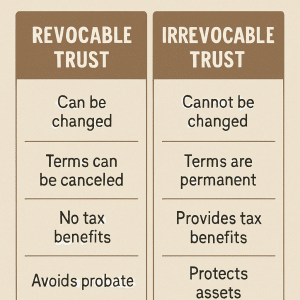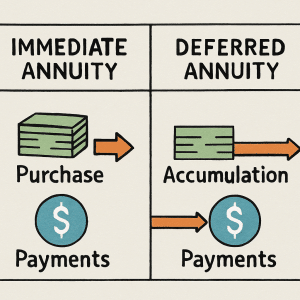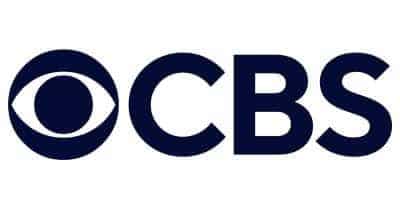What are Charitable Gift Annuities?
A charitable gift annuity (CGA) is a contractual agreement between a donor and a charity in which the donor makes a single gift to the charity in exchange for guaranteed lifetime payments.
Charitable gift annuities must follow additional terms and guidelines compared to other types of annuity contracts; I have highlighted them below.
- Your donation is an irrevocable transfer of cash or other property.
- You become eligible to take a partial tax deduction for your donation.
- The organization must be tax-exempt under section 501(c)(3) of the Internal Revenue Code.
- The payments can begin immediately or can be deferred to a future date that you choose.
- You may also establish a gift annuity for someone else; however, the total number of annuitants associated with any one gift cannot exceed two.
- The arrangement terminates on the death of the annuitant(s), at which point the charity uses the remaining funds on its mission.
How do Charitable Gift Annuities Work?
Charitable gift annuities are essentially a single premium immediate annuity; however, a charitable gift annuity is a contract between a donor and a charity (not a “trust” or insurance company). In both cases, the person who receives payments is called an “annuitant” or “beneficiary.”
The contributed property (the gift) becomes a part of the charity’s assets, and the payments are a general obligation of the charity. The annuity is backed by the charity’s entire assets, not just by the property contributed. Annuity payments continue for the life/lives of the annuitant(s) no matter what the investment experience of the gift annuity fund is.
The payments stop upon the annuitant’s death, and the remaining assets in the account go to the annuity writer. However, instead of the balance being kept by an insurance or financial services company (as with typical annuities), it is retained by the charity or nonprofit as a gift.
A charitable gift annuity may be funded with cash, securities, or a variety of other assets. Initial funding may be as little as $5,000, though they tend to be much larger.
Charitable gift annuities can help you save on taxes
Charitable gift annuities can potentially assist you in managing taxes. If you plan to establish an annuity when making charitable donations, you may qualify for an immediate tax deduction that can potentially reduce your taxable income during the year you contribute.
If you don’t capitalize the full value of your gift, you might still qualify to deduct part of your gift against your income for up to five years. These rules, and others, can complicate the process, so discuss your charitable giving strategies with a tax professional who offers free consultations.
How are Charitable Gift Annuity payments taxed?
If you fund a charitable gift annuity with a cash contribution, some of the payment will initially be taxed as ordinary income. If you fund the gift annuity with appreciated securities or real estate, some of the payments will be taxed as ordinary income, some as capital gain, and some may be tax-free. In most instances, the payments will be taxed as ordinary income.
The charity will send a Form 1099-R to the annuitant annually to show how the payments should be reported for income tax purposes. For details, tax professionals may be able to provide annuity tax information related to the taxation of gift annuities.
Who Buys Charitbable gift annuities?
Most charitable gift annuity donors are retired, want to increase their cash flow, seek the security of fixed payments that will not vary, and would like to save taxes. A charitable gift annuity might be appealing in the following circumstances: (“Donor Guide to Gift Annuities – acga-web.org”)
- CD Rates or other fixed-income investment is low and you would like to increase your cash flow.
- You own appreciated stock or mutual fund shares, have considered selling some of the shares and reinvesting the proceeds to generate more income, but don’t want to pay tax on the capital gain.
- You would like fixed annuity payments that are unaffected by interest rates and stock prices and which you cannot outlive.
- You want to assure the continuation of gift annuity payments to a loved one without the delay of probate proceedings and in a tax-efficient manner.
How are Charity Gift Annuity Payments Calculated?
The charitable gift annuity yields established by ACGA are designed to balance the attractiveness of the charity.
Gift annuity rates suggested by the ACGA have been computed to produce an average “residuum” or gift to the organization at the expiration of the agreement of approximately 50% of the amount originally donated under the agreement. Consequently, the rates are lower than and are not in competition with, annuity rates offered commercially.
If you would like to maximize the income you will receive over your lifetime, it might be better to purchase a commercial annuity.
The ACGA rates are based on actuarial studies of mortality experience among annuitants and a conservative projection of the rate of income to be earned on invested reserve funds. The ACGA engages professional actuaries to help determine the rates.
Pros and Cons of Charitable Gift Annuities
Pros
- Provides income tax deductions.
- Allows you and/or your beneficiary to receive a source of lifetime income after you and/or your beneficiary die.
- The donor earns an IRS exclusion of the entire value of the gifted assets from the value of his or her estate for federal and state estate tax purposes.
- There is a strong possibility that a portion of your annuity payout stream could be tax-free.
- You have some flexibility in what you donate beyond cash or stocks. In many cases, real estate or other personal property may qualify.
- You can curb your capital gains tax rate when you donate stocks, bonds, or personal property.
- You’re helping a favored charitable group.
Cons
- You lose control over the funds you give to the charity that created the annuity.
- Some annuity payouts are taxable.
- Payments are fixed and won’t be adjusted for inflation.
- Payments may be lower than non-charitable indemnity annuities because the primary purpose is for nonprofit support.
Charitable Gift Annuity Rates Update January 2023
“As of January 5th, the New York Department of Financial Services have posted their maximum allowed rates for Charitable Gift Annuities.” (“Gift Annuity Rates FAQs – acga-web.org”) NY is using a return assumption of 5%. As the new ACGA rates use an assumption of 4.25%, the newly released ACGA rates are lower than the maximum rates allowed by NY.
This means charities in NY, and those registered in NY can continue to use the suggested maximum ACGA rates for single and joint Charitable Gift Annuity gifts and remain in compliance with NY regulations. The ACGA continues to work directly with NY to update the statutes to avoid this conflict in the future. (“New Charitable Planning Opportunities with Retirement Plans”)
SECURE 2.0 act Changes to Charitable Gift Annuity Rules
SEC. 307. ONE-TIME ELECTION FOR QUALIFIED CHARITABLE DISTRIBUTION TO SPLIT-INTEREST ENTITY; INCREASE IN QUALIFIED CHARITABLE DISTRIBUTION LIMITATION.
(a) ONE-TIME ELECTION FOR QUALIFIED CHARITABLE DISTRIBUTION
TO SPLIT-INTEREST ENTITY. —
Section 408(d)(8) is amended by adding at the end the following new subparagraph:
‘‘(F) ONE-TIME ELECTION FOR QUALIFIED CHARITABLE DISTRIBUTION TO SPLIT-INTEREST ENTITY. —
‘‘(i) IN GENERAL. —A taxpayer may for a taxable year elect under this subparagraph to treat as meeting the requirement of subparagraph (B)(i) any distribution H. R. 2617—886 from an individual retirement account which is made directly by the trustee to a split-interest entity, but only if—
- ‘‘(I) an election is not in effect under this subparagraph for a preceding taxable year,
- ‘‘(II) the aggregate amount of distributions of the taxpayer with respect to which an election under this subparagraph is made does not exceed $50,000, and
- ‘‘(III) such distribution meets the requirements of clauses (iii) and (iv).
‘‘(ii) SPLIT-INTEREST ENTITY.—For purposes of this subparagraph, the term ‘split-interest entity’ means—
- ‘‘(I) a charitable remainder annuity trust (as defined in section 664(d)(1)), but only if such trust (“TH D CONGRESS SESSION H. R. 5171”) is funded exclusively by qualified charitable distributions,
- ‘‘(II) a charitable remainder unitrust (as defined in section 664(d)(2)), but only if such (“TH ST CONGRESS SESSION S. 243”) unitrust is funded exclusively by qualified charitable distributions, or
- ‘‘(III) a charitable gift annuity (as defined in section 501(m)(5)), but only if the such annuity is funded exclusively by qualified charitable distributions and commences fixed payments of 5 percent or greater not later than 1 year from the date of funding.
‘‘(iii) CONTRIBUTIONS MUST BE OTHERWISE DEDUCTIBLE.— A distribution meets the requirements of this clause only if—
- ‘‘(I) in the case of a distribution to a charitable remainder annuity trust or a charitable remainder unitrust, a deduction for the entire value of the remainder interest in the distribution for the benefit of a specified charitable organization would be allowable under section 170 (determined without regard to subsection (b) thereof and this paragraph), and
- ‘‘(II) in the case of a charitable gift annuity, a deduction in an amount equal to the amount of the distribution reduced by the value of the annuity described in section 501(m)(5)(B) would be allowable under section 170 (determined without regard to subsection (b) thereof and this paragraph).
‘‘(iv) LIMITATION ON INCOME INTERESTS.—A distribution meets the requirements of this clause only if—
- ‘‘(I) no person holds an income interest in the split-interest entity other than the individual for whose benefit such account is maintained, the spouse of such individual, or both, and
- ‘‘(II) the income interest in the split-interest entity is nonassignable.
‘‘(v) SPECIAL RULES.—
- ‘‘(I) CHARITABLE REMAINDER TRUSTS.—Notwithstanding section 664(b), distributions made from a trust described in subclause (I) or (II) of clause (ii) shall be treated as ordinary income in the hands of the beneficiary to whom the annuity described in section 664(d)(1)(A) or the payment described in section 664(d)(2)(A) is paid.
- ‘‘(II) CHARITABLE GIFT ANNUITIES.—Qualified charitable distributions made to fund a charitable gift annuity shall not be treated as an investment in the contract for purposes of section 72(c).’’.
(b) INFLATION ADJUSTMENT.—
Section 408(d)(8), as amended by “subsection (a), is further amended by adding at the end the following” (“Text of S. 1222 (117th): Bonneville Shoreline Trail Advancement Act …”) new subparagraph:
‘‘(G) INFLATION ADJUSTMENT.—
‘‘(i) IN GENERAL.—In the case of any taxable year beginning after 2023, each of the dollar amounts in subparagraphs (A) and (F) shall be increased by an amount equal to—
- ‘‘(I) such dollar amount, multiplied by
- ‘‘(II) the cost-of-living adjustment determined under section 1(f)(3) for the calendar year in which the taxable year begins, determined by substituting ‘the calendar year 2022’ for ‘the calendar year 2016’ in subparagraph (A)(ii) thereof.
- ‘‘(ii) ROUNDING.—If any dollar amount increased under clause (i) is not a multiple of $1,000, such dollar amount shall be rounded to the nearest multiple of $1,000.’’
(c) EFFECTIVE DATE.—
The amendment made by this section “shall apply to distributions made in taxable years beginning after” (“26 U.S. Code § 667 – Treatment of amounts deemed distributed by trust …”) the date of the enactment of this Act.












